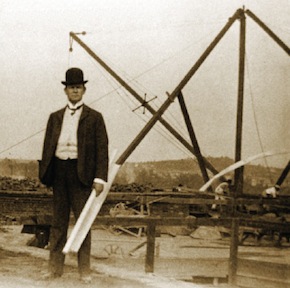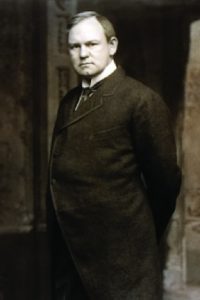EDITOR’S NOTE: Assigned to write a book concerning corruption in Pennsylvania government over the past few decades, historian Bill Keisling could not resist at times tracing corruption back to the beginning of the last century. Here is an excerpt from one of his almost 300 researches of state corruption prepared to date.
Architect of ‘The Palace of Graft’
Joseph Miller Huston, Architect, Pennsylvania Capitol Building, Harrisburg, 1901 to 1906; inmate, Eastern Penitentiary, 1911.
Huston won the competition to design the new state capitol building in Harrisburg, after the previous capitol burned down in 1897. The design competition seemed doomed from the start, as the American Institute of Architects (AIA) opposed the competition, issuing a resolution that such a competition would only “encourage favoritism and injustice” because the program was “loosely drawn and offered little promise that designs would be considered on their merits.” The AIA advised Pennsylvania architects not to enter the competition.
In the end, Huston’s winning design was one of only nine entered in the competition.
The reluctance of the architects to participate was partly fueled by an earlier competition, held in 1887 to replace the old burned-down capitol building, which resulted in an under-financed and unfinished eyesore of unadorned brick, called the Cobb Capitol, which soon was abandoned and torn down.
The second competition, in 1901, “received few entries, and many of the state’s most qualified architects had not taken part. This may have been a result of the debacle with the 1897 design competition, with architects reluctant to enter into a competition that would involve lengthy litigation and professional discredit,” recounts the Capitol Preservation Committee.
That would turn out to be an understatement.
The legislature approved spending $4 million on the new capitol. Huston certainly did a remarkable job with the detailing and construction of the building.
“After having won the competition, Huston set about paying attention to every minute detail of the new building’s construction. He, (his assistant), and several employees would design almost every feature for the Capitol, from the decorative arts to custom clocks, to escutcheon plates and doorknobs, ornate bronze railings, chandeliers, torchieres, painted finishes, and specially- designed furniture. Huston’s attention to detail was exceptionally meticulous—everything down to the last rosette, acanthus leaf, types of columns, pediments, and Greek keys would be designed, drawn, and implemented in just the location that Huston envisioned,” write state historians.
Huston’s downfall came with cost overruns and lax oversight of the building’s furnishings and appointments and even, it was alleged, outright chicanery and bribery. As the building was about to be dedicated in 1906, Democratic state Treasurer William Berry announced the supposed $4 million building had actually cost state taxpayers $13 million ($315 million in 2016 dollars), and the shocked public soon demanded a full investigation.
“Huston’s commission as architect for the capitol commission for the construction of the building and of the board of public grounds and buildings, by which it was furnished and equipped, amounted to $625,000,” a news article at the time related. “Huston collected all of his commissions except $104,000, which State Treasurer (William) Berry refused to pay on the ground that there was evidence of fraud and collusion in his transactions with the board. Huston was one of the foremost architects of Philadelphia.”
Architect Huston was the subject of two criminal trials. He was acquitted at trial with four others in 1908 on charges of over-billing for metallic furniture. But he was finally convicted on other corruption charges in 1910.
His masterpiece, the Pennsylvania state capitol building, for years would be called in the state press “The Palace of Graft.”
“Huston eventually was charged with conspiracy to defraud the State of Pennsylvania by accepting bribes for the work on the Capitol and by charging the State more than was proper for the contracts required to complete the structure,” reads his biography in the American Architects and Buildings database. “Convicted on 29 April 1910, and after an unsuccessful attempt to mount a new trial, Huston was forced to pay a fine of $500 and costs, and he entered Eastern Penitentiary on 1 June 1911 ‘for not less than six months and not more than two years’ (Evening Bulletin 1 June 1911). He served six months and 20 days in prison but was paroled on 20 December 1911 and returned to an architectural practice which was significantly affected by his legal difficulties.”
Huston designed just about everything in the capitol, including the large bronze doors in the main entranceway. The doors feature intricate decorations from Pennsylvania’s past, including a scene depicting William Penn making a peace treaty with Lenape Indians. Busts of prominent Pennsylvanians important to the construction of the capitol — including Gov. Samuel Pennypacker, and Republican political bosses Boies Penrose and Matthew Quay — decorate the edges of the door.
A miniature bust of Huston’s head conceals the door’s keyhole.
Sources: Literature in Stone: The Hundred Year History of Pennsylvania’s State Capitol, Ruthann and Jason L. Wilson, Pennsylvania Capitol Preservation Committee, Hubbert-Kemper, 2006; “Summary of Capitol Graft Cases,” Pittsburgh Press, March 6, 1910, page 39; “Will Arrest Big Grafters,” Los Angeles Herald, September 19, 1907, page 1; American Architects and Buildings database, Joseph Miller Huston biography.
See also, Capitol Graft Scandal, Capitol Investigation Commission of the Capitol Graft Scandal, Edwin Sydney Stuart, William L. Mathues, Henry Burd Cassel, George F. Payne.




